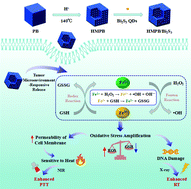Ultra-small Bi2S3 nanodot-doped reversible Fe(ii/iii)-based hollow mesoporous Prussian blue nanocubes for amplified tumor oxidative stress-augmented photo-/radiotherapy†
Abstract
Improving the generation of reactive oxygen species (ROS) while consuming glutathione (GSH) is the main method for amplifying intracellular oxidative stress. However, in previous studies, it was normally necessary to combine two or more materials to achieve the effect of destroying the intracellular redox homeostasis. This made the preparation process relatively complicated. Herein, we designed ultra-small bismuth sulfide quantum dot (Bi2S3 QD)-doped hollow mesoporous Prussian blue (HMPB) (HMPB/Bi2S3) nanocubes for amplified tumor oxidative stress to augment photo-/radiotherapy. In addition to being photothermal materials, Prussian blue can be used as both a catalyst for the Fenton reaction and a consumer of GSH due to the multivalent state of iron. Ferrous ions (Fe(II)) can produce toxic ROS-hydroxyl radicals (˙OH) with abundant hydrogen peroxide in the tumor cells by the Fenton reaction. Meanwhile, ferric ions (Fe(III)) can oxidize the intracellular GSH to GSSG, thus depleting the concentration of GSH inside tumors. As a result, oxidative stress imbalance could be induced by the reversible redox property of Fe(II/III), thereby causing DNA damage and increasing the cell membrane permeability to realize enhanced photo-/radiotherapy. As a sensitizer for radiotherapy, ultra-small Bi2S3 QDs (3–5 nm) are doped in HMPB, thus improving the therapeutic effect by prolonging blood circulation and reducing systemic toxicity via kidney metabolism. Therefore, such a reversible HMPB/Bi2S3 nanocube is a promising therapeutic agent for amplified tumor oxidative stress to augment photo-/radiotherapy, which might show further applications in nanomedical science.



 Please wait while we load your content...
Please wait while we load your content...